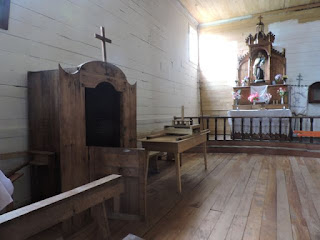A 30-minute ferry crossing away from mainland Chile across
the Chacao Channel, is Isla Chiloe, the largest in the Chiloe archipelago,
which is made up of 40 different islands with around 200,000 inhabitants. Sixteen
wooden churches are clustered around Castro in the islands east coast, each
with UNESCO World Heritage status. There are also 43 churches with national
monument status. Traditional palafitos (houses on stilts) dot its shores. The tides here can fluctuate 20-25' every twelve hours.
Spanish conquistadors came ashore on Chiloe Island in the 16th
century and founded the city of Castro (2/12/1567). Missionaries arrived soon after,
set on converting the local indigenous peoples, and quickly built up traditional
wooden churches. By the 18th century there were nearly 100 churches,
and today more than 150 churches can be found on the islands, many of which are
dedicated UNESCO World Heritage sites. The Chiloe archipelago became a major
whaling center in the 19th century, which allowed European settlers
to build up small townships on the islands. Modern day life on the islands
still very much revolves around the water, and regional food specialties consist
largely of seafood dishes. To the west, Chiloe National Park is home to foxes,
sea lions and otters and provides unspoiled terrain for horseback riding, sea
kayaking and fishing.
We went on a private tour on this
island. Our guide was Mauricio, and he was excellent, and we had a great little
bus. There were 14 of us. And, we again arrived to the island via tender.
We left from Castro to Dalcuhue where we crossed
via ferry to Qinchao Island, the second largest in the Archipelago.
Once in the island, we took a secondary road
with a great viewpoint, the Dalcuhue Channel and peninsula Rilan.
Following this road, we arrived at Curacao de
Velez, a nice small village where we walked along the square and saw its
well-preserved antique houses.
Afterwards, we went to Anchao, to saw the
architecture of the region's oldest church, built from 1730-1740. These churches are all built of wood.
Very close to the church was a very large
market that was made up of both a fish market and a goods market.
We then drove to Villa Quinohao where we
visited the oldest church that was built around 1780. You will see one picture
of the original roof and the original cross that were both displayed in the
church.
After Anchao we drove to Paredes in Palui Estero for lunch. This was a very simple building and the owners were a husband a wife. It was located right on the shore line.
As I mentioned fishing is what they do for
livelihood in these islands. They fish for salmon and oysters. The salmon in
the sea were introduced, but those in the rivers are indigent to the area.
As we drove back to the ferry we pass a number
of cemeteries. They build both their cemeteries and their churches near the
water. They build small houses around the graves so the dead can see out to the
sea.
Lastly we visited Dalcuhue and where there was
also a market, very similar to the one that we had already been to. We were
almost out of time so we did not stay long. We did see a little of the area.
The tree pictured here is a Monkey Tree.
Finally back to the ship.
As we left these islands we saw our first
penguins off the ship. They were small, but they were swimming along with us.
The backdrop was the Andes.




















































No comments:
Post a Comment